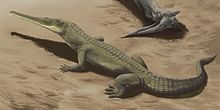
Archosauria is a clade of diapsid sauropsid tetrapods, with birds and crocodilians being the only living representatives. Archosaurs are broadly classified as reptiles, in the cladistic sense of the term, which includes birds. Extinct archosaurs include non-avian dinosaurs, pterosaurs and extinct relatives of crocodilians. Modern paleontologists define Archosauria as a crown group that includes the most recent common ancestor of living birds and crocodilians, and all of its descendants. The base of Archosauria splits into two clades: Pseudosuchia, which includes crocodilians and their extinct relatives; and Avemetatarsalia, which includes birds and their extinct relatives.

Archosauriformes is a clade of diapsid reptiles encompassing archosaurs and some of their close relatives. It was defined by Jacques Gauthier (1994) as the clade stemming from the last common ancestor of Proterosuchidae and Archosauria. Phil Senter (2005) defined it as the most exclusive clade containing Proterosuchus and Archosauria. Archosauriforms are a branch of archosauromorphs which originated in the Late Permian and persist to the present day as the two surviving archosaur groups: crocodilians and birds.

"Rauisuchia" is a paraphyletic group of mostly large and carnivorous Triassic archosaurs. Rauisuchians are a category of archosaurs within a larger group called Pseudosuchia, which encompasses all archosaurs more closely related to crocodilians than to birds and other dinosaurs. First named in the 1940s, Rauisuchia was a name exclusive to Triassic archosaurs which were generally large, carnivorous, and quadrupedal with a pillar-erect hip posture, though exceptions exist for all of these traits. Rauisuchians, as a traditional taxonomic group, were considered distinct from other Triassic archosaur groups such as early dinosaurs, phytosaurs, aetosaurs, and crocodylomorphs.
Phytosaurs are an extinct group of large, mostly semiaquatic Late Triassic archosauriform reptiles. Phytosaurs belong to the order Phytosauria. and are sometimes referred to as parasuchians. Phytosauria, Parasuchia, Parasuchidae, and Phytosauridae have often been considered equivalent groupings containing the same species. Some recent studies have offered a more nuanced approach, defining Parasuchidae and Phytosauridae as nested clades within Phytosauria as a whole. Phytosaurs were long-snouted and heavily armoured, bearing a remarkable resemblance to modern crocodilians in size, appearance, and lifestyle, as an example of convergence or parallel evolution

Euparkeria is an extinct genus of archosauriform reptile from the Triassic of South Africa. Euparkeria is close to the ancestry of Archosauria, the reptile group that includes crocodilians, pterosaurs, and dinosaurs.
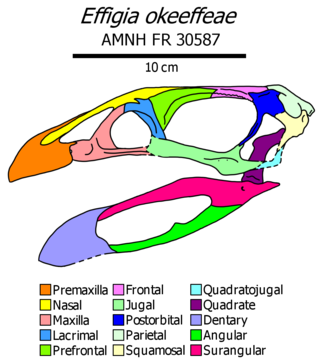
Effigia was an extinct genus of shuvosaurid known from the Late Triassic of New Mexico, south-western USA. With a bipedal stance, long neck, and a toothless beaked skull, Effigia and other shuvosaurids bore a resemblance to the ornithomimid dinosaurs of the Cretaceous Period. However, shuvosaurids were not dinosaurs, but were instead a specialized family of poposauroid pseudosuchians, meaning that their closest living relatives are crocodilians.

Gracilisuchus is an extinct genus of tiny pseudosuchian from the Late Triassic of Argentina. It contains a single species, G. stipanicicorum, which is placed in the clade Suchia, close to the ancestry of crocodylomorphs. Both the genus and the species were first described by Alfred Romer in 1972.

Riojasuchus is an extinct genus of ornithosuchid archosaur from the Late Triassic (Norian) of Argentina. Ornithosuchidae was a widespread family of facultatively bipedal pseudosuchians with adaptations for scavenging. Riojasuchus is notable as one of the youngest and most complete members of the family. The type and only known species, Riojasuchus tenuisceps, was named and described by José Bonaparte in 1967. It was one of the first of many well-preserved Triassic archosaurs to be discovered in Argentina. The holotype specimen, PVL 3827, was found in the Los Colorados Formation of the Ischigualasto-Villa Unión Basin in northwestern Argentina.

Pseudosuchia is one of two major divisions of Archosauria, including living crocodilians and all archosaurs more closely related to crocodilians than to birds. Pseudosuchians are also informally known as "crocodilian-line archosaurs". Despite Pseudosuchia meaning "false crocodiles", the name is a misnomer as true crocodilians are now defined as a subset of the group.
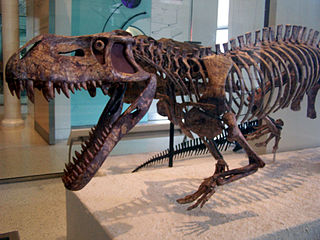
Prestosuchidae is a polyphyletic grouping of carnivorous archosaurs that lived during the Triassic. They were large active terrestrial apex predators, ranging from around 2.5 to 7 metres in length. They succeeded the Erythrosuchidae as the largest archosaurs of their time. While resembling erythrosuchids in size and some features of the skull and skeleton, they were more advanced in their erect posture and crocodile-like ankle, indicating more efficient gait. "Prestosuchids" flourished throughout the whole of the middle, and the early part of the late Triassic, and fossils are so far known from Europe, India, Africa (Tanzania), Argentina, and Paleorrota in Brazil. However, for a long time experts disagree regarding the phylogenetic relationships of the group, what genera should be included, and whether indeed the "Prestosuchidae" constitute a distinct family.

Poposaurus is an extinct genus of pseudosuchian archosaur from the Late Triassic of the southwestern United States. It belongs to the clade Poposauroidea, an unusual group of Triassic pseudosuchians that includes sail-backed, beaked, and aquatic forms. Fossils have been found in Wyoming, Utah, Arizona, and Texas. Except for the skull, most parts of the skeleton are known. The type species, P. gracilis, was described and named by Maurice Goldsmith Mehl in 1915. A second species, P. langstoni, was originally the type species of the genus Lythrosuchus. Since it was first described, Poposaurus has been variously classified as a dinosaur, a phytosaur, and a "rauisuchian".

Avemetatarsalia is a clade of diapsid reptiles containing all archosaurs more closely related to birds than to crocodilians. The two most successful groups of avemetatarsalians were the dinosaurs and pterosaurs. Dinosaurs were the largest terrestrial animals for much of the Mesozoic Era, and one group of small feathered dinosaurs has survived up to the present day. Pterosaurs were the first flying vertebrates and persisted through the Mesozoic before dying out at the Cretaceous-Paleogene (K-Pg) extinction event. Both dinosaurs and pterosaurs appeared in the Triassic Period, shortly after avemetatarsalians as a whole. The name Avemetatarsalia was first established by British palaeontologist Michael Benton in 1999. An alternate name is Pan-Aves, or "all birds", in reference to its definition containing all animals, living or extinct, which are more closely related to birds than to crocodilians.

Ornithosuchidae is an extinct family of pseudosuchian archosaurs from the Triassic period. Ornithosuchids were quadrupedal and facultatively bipedal, meaning that they had the ability to walk on two legs for short periods of time. They had distinctive, downturned snouts, unique, "crocodile-reversed" ankle bones, and several other features that distinguish them from other archosaurs. Ornithosuchids were geographically widespread during the Carnian and Norian stages of the Late Triassic with members known from Argentina, Brazil, and the United Kingdom. Four genera, comprising Ornithosuchus, Venaticosuchus, Dynamosuchus, and Riojasuchus are presently known. The family was first erected by German paleontologist Friedrich von Huene in 1908.

A crurotarsal joint is one that’s situated between the bones of crus, i.e. shin and the proximal tarsal bones, i.e. astragalus and calcaneum.
Yarasuchus is an extinct genus of avemetatarsalian archosaur that lived during the Anisian stage of the Middle Triassic of India. The genus was named and described in 2005 from a collection of disarticulated but fairly complete fossil material found from the Middle Triassic Yerrapalli Formation. The material is thought to be from two individuals, possibly three, with one being much more complete and articulated than the other. The type and only species is Y. deccanensis. Yarasuchus was a quadruped roughly 2–2.5 metres (6.6–8.2 ft) long, with an elongated neck and tall spines on its vertebrae. Unlike other quadrupedal Triassic reptiles, the limbs and shoulders of Yarasuchus were slender, and more like those of ornithodirans.

Suchia is a clade of archosaurs containing the majority of pseudosuchians. It was defined as the least inclusive clade containing Aetosaurus ferratus, Rauisuchus tiradentes, Prestosuchus chiniquensis, and Crocodylus niloticus by Nesbitt (2011). Generally the only pseudosuchian group which is omitted from Suchia is the family Ornithosuchidae, although at least one analysis classifies ornithosuchids as close relatives of erpetosuchids and aetosaurs. Phytosaurs are also excluded from Suchia, although it is not certain whether they qualify as pseudosuchians in the first place.
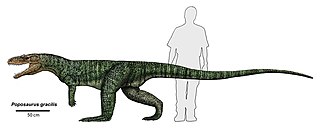
Poposauroidea is a clade of advanced pseudosuchians. It includes poposaurids, shuvosaurids, ctenosauriscids, and other unusual pseudosuchians such as Qianosuchus and Lotosaurus. It excludes most large predatory quadrupedal "rauisuchians" such as rauisuchids and "prestosuchids". Those reptiles are now allied with crocodylomorphs in a clade known as Loricata, which is the sister taxon to the poposauroids in the clade Paracrocodylomorpha. Although it was first formally defined in 2007, the name "Poposauroidea" has been used for many years. The group has been referred to as Poposauridae by some authors, although this name is often used more narrowly to refer to the family that includes Poposaurus and its close relatives.

Paracrocodylomorpha is a clade of pseudosuchian archosaurs. The clade includes the diverse and unusual group Poposauroidea as well as the generally carnivorous and quadrupedal members of Loricata, including modern crocodylians. Paracrocodylomorpha was named by paleontologist J. Michael Parrish in 1993, although the group is now considered to encompass more reptiles than his original definition intended. The most recent definition of Paracrocodylomorpha, as defined by Sterling Nesbitt in 2011, is "the least inclusive clade containing Poposaurus and Crocodylus niloticus. Most groups of paracrocodylomorphs became extinct at the end of the Triassic period, with the exception of the crocodylomorphs, from which crocodylians such as crocodiles and alligators evolved in the latter part of the Mesozoic.
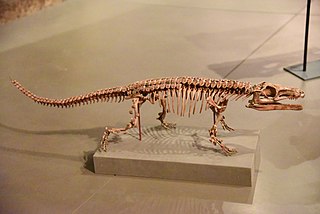
Erpetosuchidae is an extinct family of pseudosuchian archosaurs. Erpetosuchidae was named by D. M. S. Watson in 1917 to include Erpetosuchus. It includes the type species Erpetosuchus granti from the Late Triassic of Scotland, Erpetosuchus sp. from the Late Triassic of eastern United States and Parringtonia gracilis from the middle Middle Triassic of Tanzania; the group might also include Dyoplax arenaceus from the Late Triassic of Germany, Archeopelta arborensis and Pagosvenator candelariensis from Brazil and Tarjadia ruthae from Argentina.
Nundasuchus is an extinct genus of crurotarsan, possibly a suchian archosaur related to Paracrocodylomorpha. Remains of this genus are known from the Middle Triassic Manda beds of southwestern Tanzania. It contains a single species, Nundasuchus songeaensis, known from a single partially complete skeleton, including vertebrae, limb elements, osteoderms, and skull fragments.
